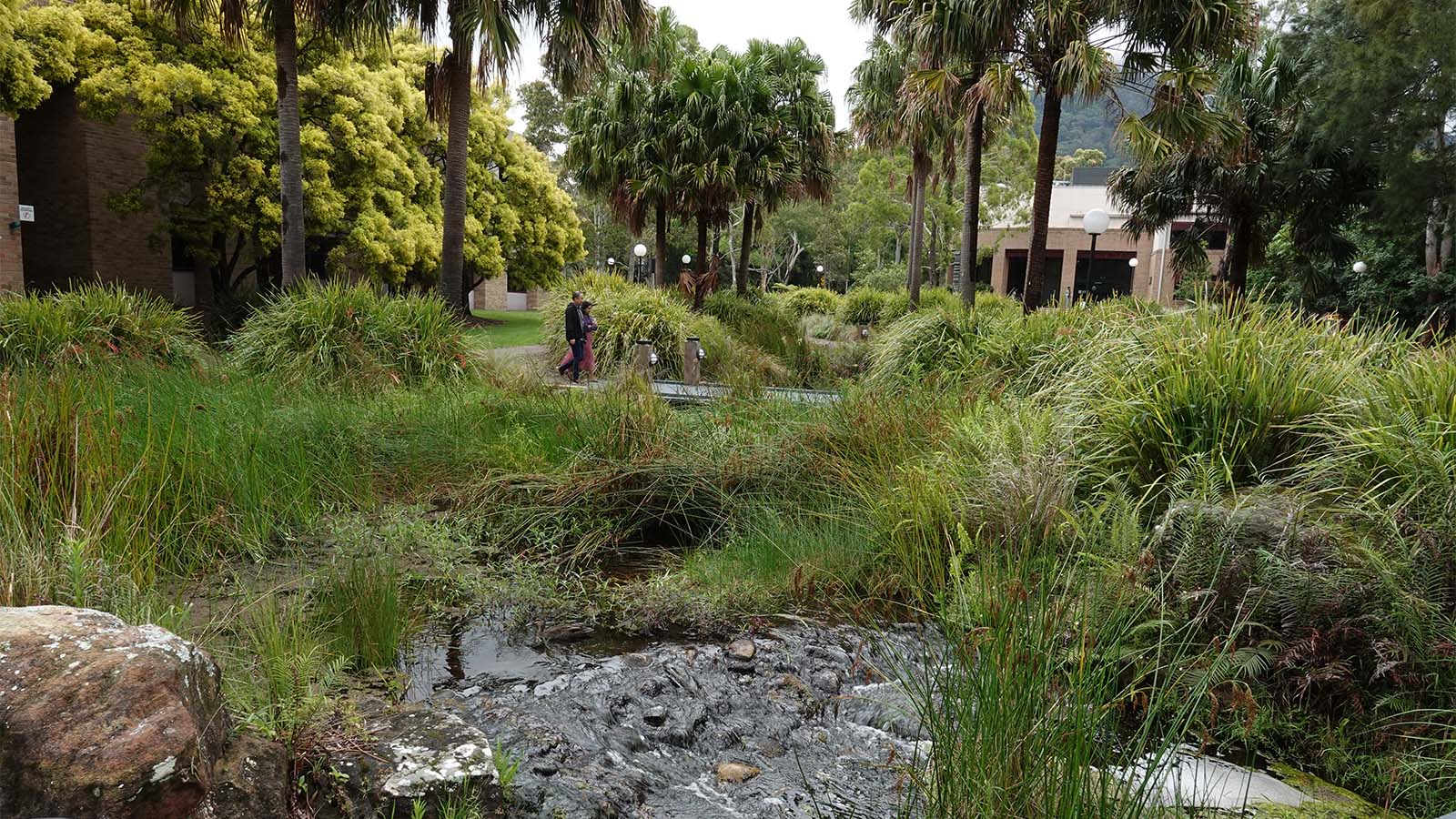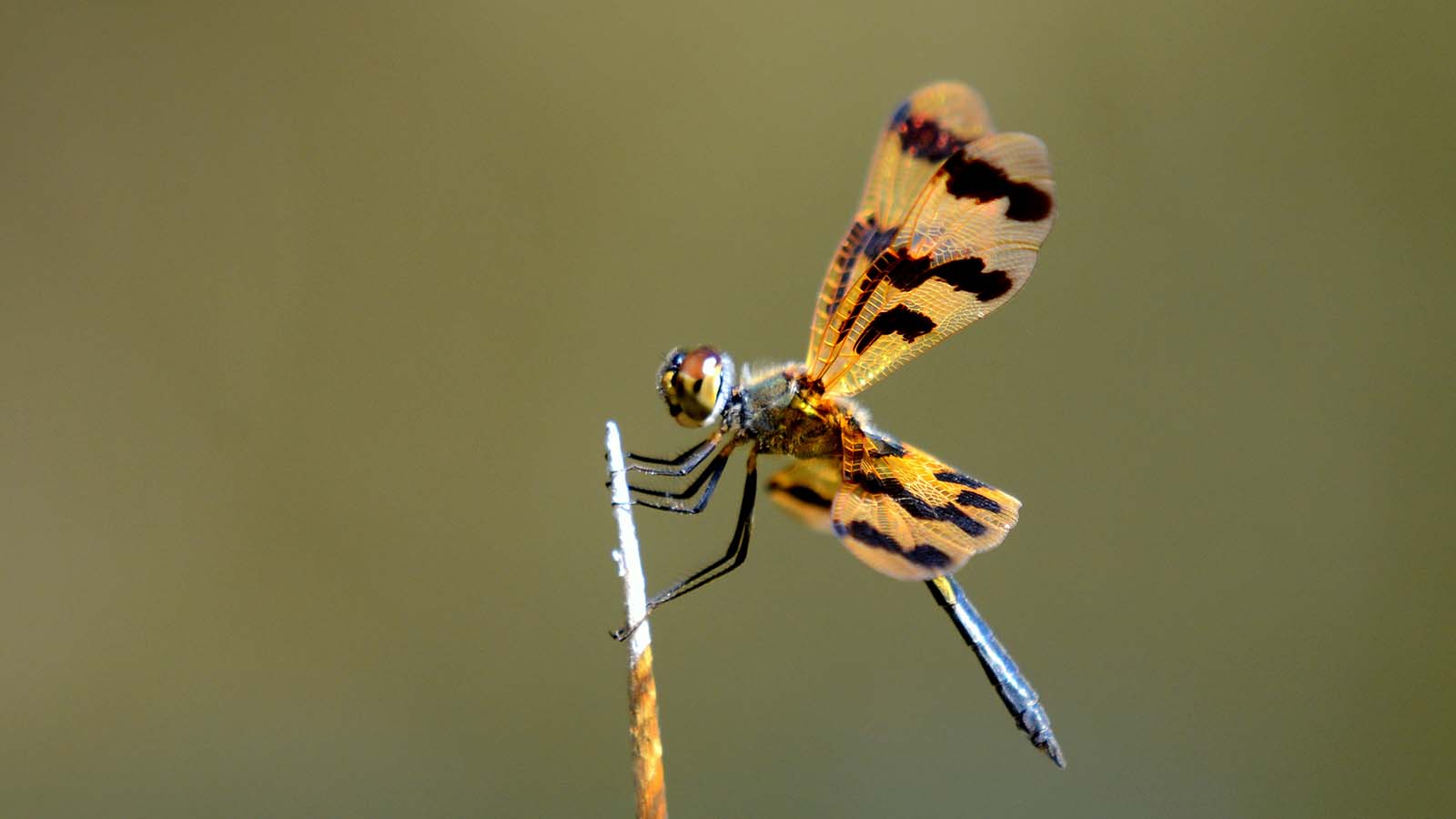The beautiful diversity of UOW's flora and fauna
Why have a university covered with local native trees, gardens and animals?
February 27, 2024
How purposeful planting shaped UOW's biodiversity
When newcomers visit the University of Wollongong, it’s common for them to think that the campus was cut out of the local natural forest, with buildings nestled amongst mature trees and shrubby green spaces. But looking at the aerial photo of the site from the 1950s, it shows a completely cleared dairy farm with corn fields and only a few remnant trees along the creek lines. A recent image of the same area shows a stark contrast, with a mix of tall trees, reedy water features, shrubby green spaces, and a healthy canopy. Almost all the vegetation on campus has been purposely planted and regenerated to form the green, biodiverse environment that it is today.

The University of Wollongong sits on 86 hectares at the foot of the Illawarra Escarpment, with 95 buildings, 2000 staff, and around 17000 people on campus on any given day. The management of the outdoor areas, with sports fields, ponds, bushland areas and many mature trees, is certainly a large undertaking. The Tree Management Program has over 5000 trees assessed and tagged, with an estimated 18000 trees on the whole site.
Before European arrival more than 200 years ago, the area on which the University stands, would have been a mix of pristine coastal plain and escarpment foothills plant communities. Coastal Plain Melaleuca Forest and Dry Rainforest on the lowlands, Forest Redgum Grasslands on the foothills, Eucalypt/Turpentine Forest on escarpment spurs, and Sub-tropical Rainforest in the gullies and creek lines.

In 1962, a Teacher’s College was built on the old, cleared farm site and 1969 saw the arrival of the University. As more buildings were constructed, the land was levelled and filled with slag and coal wash from local heavy industries. It was a bleak, dusty, shadeless, windswept, inhospitable space, with the only vegetation being roses, camellias, pines and maples, around the teacher’s college. In these early days, there was no real thought for the environment of the site.
In the early 1970s a great change would take place. The University’s first Head Gardener, Charlie House, and Head of Physics, Ken Ausburn, teamed up to start planting native trees and plants with great tenacity against the management, who loved their ‘coal wash and roses’.

Nocturnal animals of UOW: sugar glider (top left), lesser long eared bat (top right), litoria peroni peron's tree frog (bottom left) and boo-book owl (bottom right).
1973 saw the arrival of the first Vice-Chancellor, Michael Birt, and a Buildings Site Committee was formed. Michael was an open-minded man with a great feeling for the environment and the beautification of the University Campus began. The race was on, to plant quick-growing natives and large tree species for shade, screening and softening buildings, and mass plantings to hide unsightly roads and car parks.
The mid 1970s saw the arrival of Leon Fuller, the first Landscape Superintendent, who took up the planting policy with gusto, adding thousands of native plants and trees. Leon pushed for local area natives to be used, as they were suited to local conditions and required the least maintenance. He carried out his own research on propagation of local species for planting, due to the scarcity of commercially available stock. His work extended outside into the community, by pushing the Green Corridor concept, which involved bringing fingers of native escarpment bushland down through urban areas, to join the sea, creating wildlife corridors.

When Leon left for greener pastures, David Walker, Head Landscaper, continued the good work and vision as the University was transforming from a coal wash desert into a landscape of distinction. In the late 1970s the Enlightened Building Policy was formed which dealt with building heights, placement and working with the landscape to create a unique setting.
In the 1980s and 90s, Martin Bramston, Landscape Supervisor, continued the good work. He had a love for design and water features, overseeing the construction of ponds and running stream waterways to further enhance the campus environment. As more buildings sprung up and the campus community grew, the Landscape Department became more involved in the design and consultation process on landscaping and plantings around new constructions.
Bush regeneration is also an important part of greening of the university grounds. Weed reduction and regeneration of the creek lines and the bush escarpment on the west side of campus is ongoing and ensures wild areas are managed to promote biodiversity. In more recent times, there have been efforts to plant specifically for an increase in habitat and biodiversity. Simply planting natives and building suitable areas of habitat, sees the creatures arrive. An amazing number of native animals can be seen on campus and are an asset for the university with students photographing the grounds and the unique critters that live there. Insects, frogs, reptiles, possums, bats, echidnas, and many types of birds, including powerful owl, lorikeets, honeyeaters, ducks, and waterfowl live on campus, all because of natural native plantings.

The many species of animals found at UOW campus: ring tail possum (top left), tawney frogmouth (top right and bottom left) and red-bellied black snake (bottom right).
From 2013 to 2019, Landscape Supervisor Mark Spence pushed his passion for the environment, with more green space creation. Frog ponds and natural teaching areas were constructed and after a complete assessment of the waterways, mass plantings of native aquatic species around ponds and water courses took place, resulting in natural barriers for safety, improved water quality, erosion control and increased biodiversity.
Current Supervisor, Mark Haining, continues the landscape development, evolution and management of the outdoor spaces with a modern Australian design feel, focusing on mature tree management, rainforest plantings, impacts of festivals and events, and guiding the department into the future.
The Landscape Department also liaises with various faculties at the University to help with student education and studies by creating spaces and specific learning and teaching areas, like frog ponds, insect, aquatic and bird habitats, so students don’t have to go off site for practical studies. We have unique and beautiful fauna and flora in Australia, and for the many international students that come to the campus to study in a place that is alive with native plants and animals, it is a real drawcard. These students are taking photos and footage of the local colourful plants, birds and wildlife to send back home to the rest of the world.

So why have a university covered with local native trees, gardens and animals?
- The large trees and green vegetation spaces on campus gives a pleasant learning and working experience, providing wind breaks, shade, thermal regulation of buildings and open areas.
- Large buildings are softened or hidden by plantings, giving a forested parkland atmosphere, with great outlooks from offices and venues.
- It is healthier and more enjoyable to be in a natural environment; surrounded by greenery and grounded to nature, in a campus that is biodiverse, green and full of life.
- A beautiful campus, alive with native plants and animals, is a valuable drawcard for students, employees and the surrounding community.
- Onsite learning and study areas are an asset for students, preventing the need to travel to other locations.
- With the impact of post European settlement on Australia’s east coast ecosystems there is a sense of obligation to create and maintain a biodiverse environment.
The University of Wollongong grounds are a fantastic example of how our decisions can impact the health and wellbeing of our natural spaces and how, with time and commitment, positive transformations can occur.
Anthony Wardle has worked for the University of Wollongong Landscape Department for the past 31 years. He has extensive knowledge of the history, flora and fauna of Wollongong’s main campus.
This article has been originally written for Australian Native Plant Society of NSW and is republished here with the author's permission.